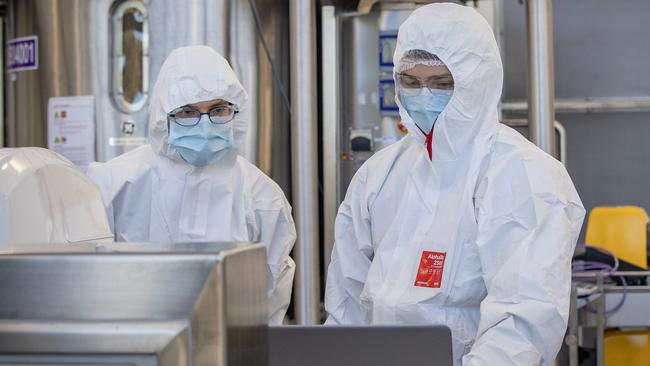Oxford AstraZeneca coronavirus vaccine goes to top of class
Australia’s preferred vaccine, the Oxford AstraZeneca jab, is up to 90 per cent effective, stage-three data shows.

Australia’s preferred vaccine, the Oxford AstraZeneca jab, is up to 90 per cent effective, and as well as protecting people from the effects of COVID-19, it also appears to reduce the transmission of the coronavirus, stage-three data shows.
The eagerly awaited results showed both good and disappointing news: the 90 per cent rate was achieved with a two-dose regime, the first of which was only half-strength.
Australia has an agreement to buy and make 33 million doses of the vaccine, and manufacturing has already begun, with the first batches being rolled out by the new year.
While the adjusted first dose proved highly effective, when researchers gave volunteers the two doses at full strength, the efficacy rate plunged to 62.4 per cent. This is well below the standards set by rival vaccines from Moderna and Pfizer BioNTech, both of which showed nearly 95 per cent effectiveness. Using the two studies together, the Oxford vaccine is considered 70.4 per cent effective, but unlike the other vaccines, it can be stored in a fridge, meaning the logistics of distributing it are easier and safer.
Oxford researchers said on Monday there were early indications the vaccine could also reduce virus transmission from an observed reduction in asymptomatic infections.
Professor Andrew Pollard, director of the Oxford Vaccine Group, said: “These findings show that we have an effective vaccine that will save many lives. Excitingly, we’ve found that one of our dosing regimens may be around 90 per cent effective and if this dosing regimen is used, more people could be vaccinated with planned vaccine supply.”
There were also lower levels of asymptomatic infection in those who received the lower dose first, which “means we might be able to halt the virus in its tracks”, Professor Pollard said.
More than 24,000 volunteers in Britain, Brazil and South Africa have been part of the Oxford trial, which uses a viral vaccine (ChAdOx1 nCoV-19) — a weakened version of a cold virus genetically changed so that it is impossible for it to grow in humans.
The results add to the peer-reviewed earlier stage one and two trial results, which show the vaccine induces strong antibody and T-cell immune responses across all age groups.
The researchers said there were no hospitalised or severe cases in anyone who received the vaccine and — crucially — the vaccine can be easily administered in existing healthcare systems, stored at fridge temperature (2C-8C) and distributed using existing logistics. While the half-dose first shot may initially complicate manufacture of the vaccine, it also means the first shots can be rolled out quicker.
Sarah Gilbert, professor of vaccinology at the University of Oxford, said: “The announcement today takes us another step closer to the time when we can use vaccines to bring an end to the devastation caused by SARS-CoV-2. We will continue to work to provide the detailed information to regulators.”




To join the conversation, please log in. Don't have an account? Register
Join the conversation, you are commenting as Logout